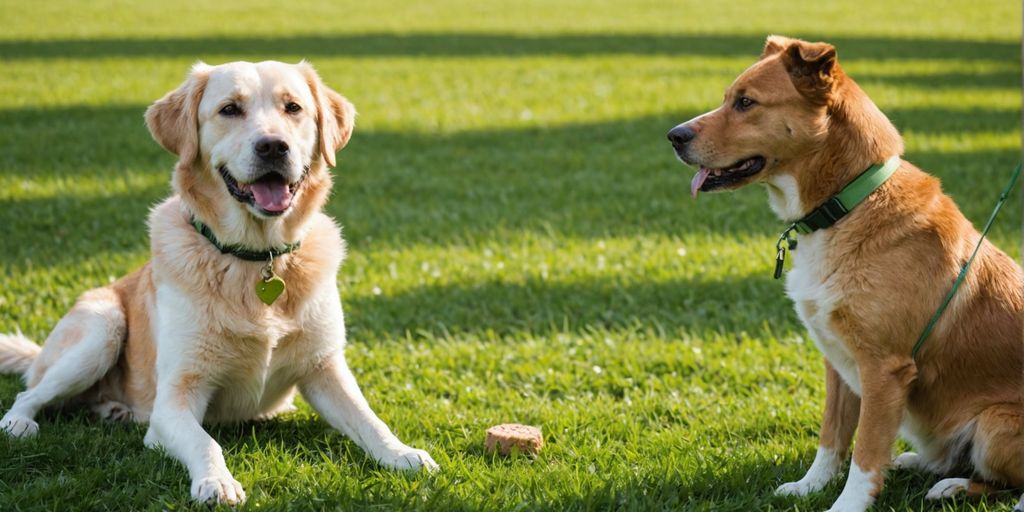Training your dog to be obedient is essential for a happy and healthy relationship between you and your furry friend. Many people love their dogs but struggle with unwanted behaviors that can make life difficult. This article will guide you through effective techniques to train your dog, ensuring a well-behaved companion.
Key Takeaways
- Early training sets the foundation for good behavior throughout your dog's life.
- Positive reinforcement, like treats and praise, encourages desired behaviors.
- Clicker training is an effective method that uses a distinct sound to mark good behavior.
- Addressing behavioral issues like barking and aggression early can prevent future problems.
- Choosing the right training method depends on your dog's personality and needs.
Understanding the Basics of Dog Obedience Training
Training your dog is a crucial step in ensuring they are well-behaved and happy. Basic obedience training is essential for a well-behaved dog, fostering a strong bond between owner and pet. Here are some foundational aspects to consider when starting your dog's training journey.
Positive Reinforcement Techniques
Positive reinforcement is a popular and humane method for training dogs. It focuses on rewarding good behavior to encourage its repetition. This approach not only helps in training but also strengthens the bond between you and your dog.
Using Treats and Rewards
Treats are a common way to reward your dog. When your dog performs a desired behavior, give them a treat immediately. This helps them understand what behavior is being rewarded. Consistency is crucial; always reward the behavior you want to see more of.
Praise and Affection
Sometimes, a simple "Good boy!" or a pat on the head can be just as effective as a treat. Dogs love attention and affection from their owners. Use praise to reinforce good behavior, especially if you're out of treats.
Timing and Consistency
The timing of the reward is essential. Give the reward immediately after the desired behavior to make the connection clear. Consistency in your training routine helps your dog understand what is expected of them. This prevents confusion and helps in preventing behavioral problems in dogs.
Positive reinforcement not only trains your dog but also builds trust and a positive relationship between you and your pet.
Clicker Training for Dogs
How Clicker Training Works
Clicker training is a popular method of positive reinforcement. It involves using a small device that makes a clicking sound to mark the exact moment your dog performs a desired behavior. This sound acts as a signal that a reward is coming, helping your dog understand what action is being praised. You can use a variety of markers, such as a verbal cue like "Yes!" or even a thumbs-up gesture.
Benefits of Clicker Training
Clicker training is highly adaptable and can be used for all types of dog training, from basic commands to advanced skills like agility. It helps improve the timing of your praises and rewards, making the training process clearer for your dog. Additionally, it can be used with dogs of all ages and breeds, and even those with hearing issues by using visual or tactile markers.
Steps to Implement Clicker Training
- Charge the Clicker: Start by associating the clicker sound with a reward. Click the device and immediately give your dog a treat. Repeat this several times until your dog understands that the click means a treat is coming.
- Introduce Commands: Once your dog associates the click with a reward, you can start using it to mark desired behaviors. For example, say "Sit," and click the moment your dog sits, then give a treat.
- Practice Consistently: Consistency is key in clicker training. Make sure to click at the exact moment your dog performs the desired behavior and follow it up with a reward every time.
- Expand Training: As your dog becomes more familiar with the clicker, you can use it to teach more complex commands and tricks. Gradually increase the difficulty and introduce new environments to ensure your dog can perform the behaviors anywhere.
Clicker training is a clear and humane way to communicate with your dog, making the training process enjoyable for both of you.
Addressing Common Behavioral Issues
Dealing with Excessive Barking
Excessive barking can be a nuisance, but understanding why your dog barks is the first step. Dogs bark for various reasons, such as boredom, anxiety, or to alert you. Identifying the cause can help you address the issue more effectively. For instance, if your dog barks out of boredom, increasing their physical activity and mental stimulation can help reduce the barking.
Managing Aggression
Aggression in dogs can be alarming and dangerous. It's crucial to identify the triggers that cause your dog to become aggressive. Common triggers include fear, territorial behavior, and frustration. Once you know the triggers, you can work on desensitizing your dog to them. Positive reinforcement techniques can be very effective in managing aggression. Reward your dog for calm behavior and gradually expose them to the triggers in a controlled manner.
Handling Separation Anxiety
Separation anxiety occurs when a dog becomes stressed and anxious when left alone. Symptoms include destructive behavior, excessive barking, and house soiling. To help your dog cope with separation anxiety, start by leaving them alone for short periods and gradually increase the duration. Creating a safe and comfortable space for your dog can also help. Additionally, providing them with toys and treats can keep them occupied and reduce anxiety.
Consistency and patience are key when addressing behavioral issues in dogs. With the right approach, you can help your dog become a well-behaved and happy member of your family.
Advanced Obedience Training Methods
Off-Leash Training
Off-leash training is a significant milestone in a dog's obedience journey. It allows your dog to roam freely while still obeying commands. Start in a secure, enclosed area and gradually introduce distractions. Consistency and patience are key to success.
Recall Training
Recall training focuses on teaching your dog to come back to you when called. This is crucial for their safety. Use high-value treats and positive reinforcement to make coming back to you a rewarding experience. Practice in various environments to ensure reliability.
Agility and Trick Training
Agility and trick training not only provide physical exercise but also mental stimulation for your dog. Set up an agility course in your backyard or join a local club. Teaching tricks like rolling over or playing dead can be fun and strengthen your bond with your dog.
Advanced training methods like off-leash and recall training can significantly enhance your dog's obedience and your overall relationship.
Choosing the Right Training Method for Your Dog
Assessing Your Dog's Personality
Every dog is unique, and their training should reflect that. Some dogs require more patience and time to build confidence, while others thrive on new challenges. Consider your dog's history and personality. For instance, a nervous dog might do better with reward-based training, like using treats as lures.
Consulting a Professional Trainer
If you're struggling to find the right method, a professional trainer can be invaluable. Trainers can help adapt techniques to suit your dog's needs. Don't hesitate to seek help, especially if your dog shows signs of aggression or fearfulness.
Blending Different Training Approaches
Sometimes, combining methods yields the best results. For example, many puppy classes use a mix of positive reinforcement and clicker training. If one approach isn't working, don't be afraid to try another or blend a few together.
Avoiding Common Training Mistakes
Training your dog can be a rewarding experience, but it's easy to make mistakes along the way. Here are some common pitfalls to avoid to ensure your training is effective and enjoyable for both you and your dog.
Inconsistent Commands
One of the biggest mistakes is giving inconsistent commands. If you use different words or tones for the same command, your dog will get confused. Always use the same word and tone for each command to help your dog understand what you want.
Overusing Punishment
Using punishment too often can harm your relationship with your dog. Instead of focusing on what your dog does wrong, try to reward the behaviors you want to see. This positive approach will make training more enjoyable for your dog and more effective in the long run.
Neglecting Socialization
Socialization is crucial for a well-behaved dog. Make sure to expose your dog to different people, places, and other animals. This will help them become more confident and less likely to develop behavioral issues.
Remember, training should be a positive experience for both you and your dog. Avoiding these common mistakes can make a big difference in your dog's behavior and your overall training success.
Conclusion
Training your dog can be a rewarding experience for both you and your furry friend. By using effective techniques, you can teach your dog to behave well and follow commands. Whether you choose positive reinforcement, clicker training, or another method, the key is to be patient and consistent. Remember, every dog is different, so what works for one might not work for another. The most important thing is to build a strong bond with your dog and make the training process enjoyable. With time and effort, you'll have a well-behaved dog that brings joy to your life.
Frequently Asked Questions
When should I start training my dog?
It's best to start training your dog as early as possible, ideally when they are still a puppy. Early training helps establish good behavior patterns and makes it easier for your dog to learn new commands.
What is positive reinforcement in dog training?
Positive reinforcement involves rewarding your dog for good behavior. This can be in the form of treats, praise, or playtime. The goal is to encourage the dog to repeat the behavior that earned the reward.
How does clicker training work?
Clicker training uses a small device that makes a clicking sound to mark the exact moment your dog performs a desired behavior. This is usually followed by a treat or other reward. The click helps the dog understand exactly what action is being rewarded.
How can I stop my dog from barking too much?
To reduce excessive barking, try to identify the cause first. It could be boredom, fear, or attention-seeking. Use positive reinforcement to reward quiet behavior and redirect your dog's attention when they start barking.
Is it ever too late to train an older dog?
No, it's never too late to train a dog. While puppies may learn faster, older dogs are perfectly capable of learning new tricks and behaviors. Patience and consistency are key.
Should I consult a professional trainer?
If you're struggling with training your dog or dealing with specific behavioral issues, consulting a professional trainer can be very helpful. They can provide personalized advice and techniques tailored to your dog's needs.

